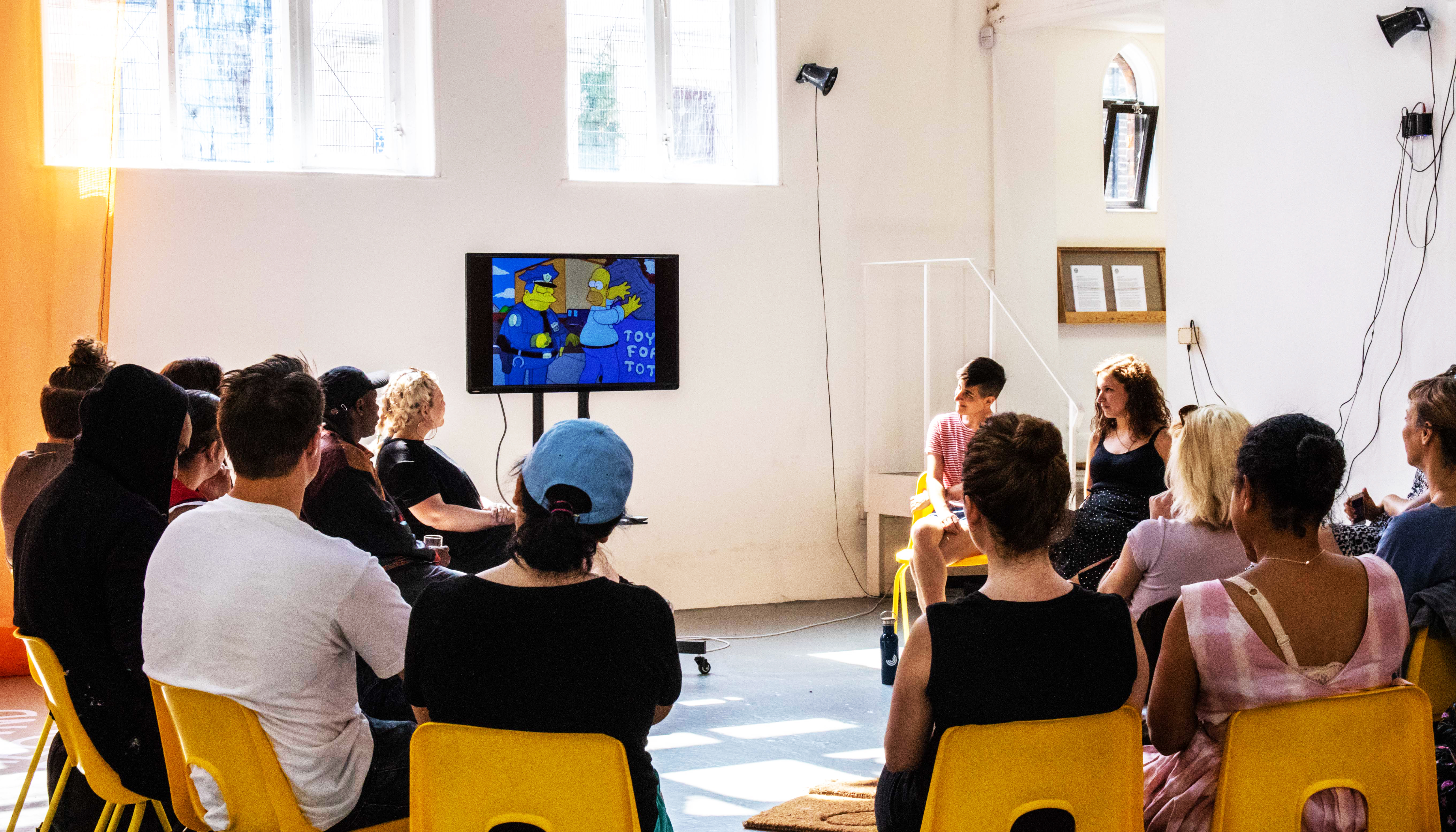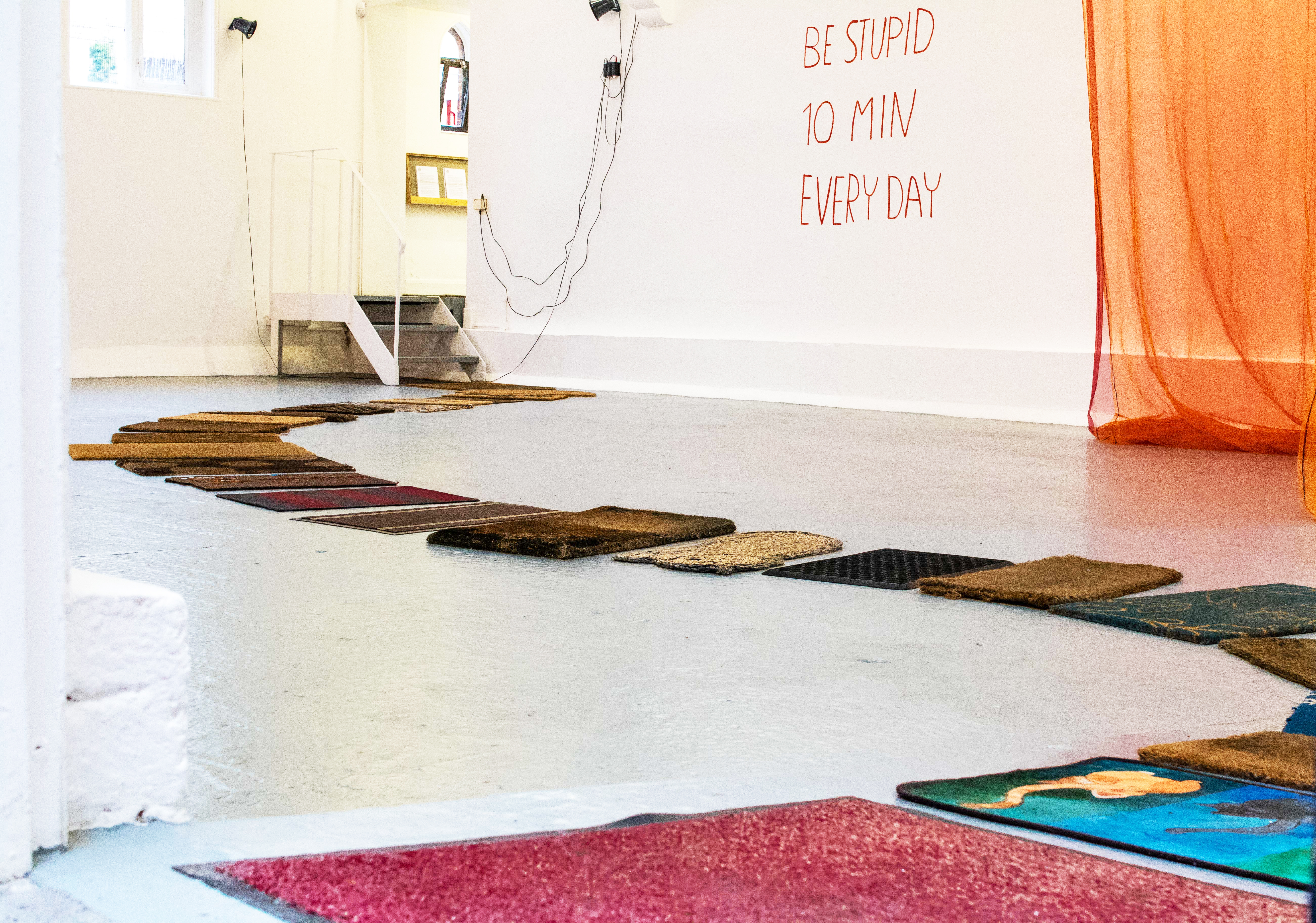“Lisa, that’s it! I’ve got an idea for a wonderful art project that’ll make everyone love me again! Step one: steal all the doormats in town” says Homer in The Simpsons episode ‘Mom and Pop Art’ – a quote that opens the press release of They Are Here‘s exhibition Laughing Matter at London’s Studio Voltaire, running May 24 to June 10. The line is also the starting point for ‘Welcome’ (2018), in which the collaborative duo, ‘steered by’ Helen Walker and Harun Morrison, lay out a trail of welcome mats throughout the gallery, all loaned by responders of a local call out. The work is one of many produced through collaboration, play and humour.

“What interested us about laughter is how it both psychologically and physiologically alleviates stress” they note when I ask them about their title choice, “Laughing Matter is a counterpoint to the phrase ‘no laughing matter.’ Perhaps the title also speaks of the evocative capacity of everyday things when assembled.” The exhibition is the final instalment informed by a labyrinth of events, performances and workshops that have taken place over the past year during their residency at the space.
Each element in the room takes the form of an exchange; a wall-based text made in collaboration with Rosalie Schweiker reads ‘Be Stupid 10 min Every day’, a floor-based text ‘STAND HERE UNTIL YOU FIND SOMEONE TO REPLACE YOU’ waits to be activated, a sound piece of layered laughter recordings taken from friends in ‘uncertain times’, or the large hanging sculpture made of heavy debris netting that acts as a backdrop for “an evening of live comedy by Londoners negotiating precarity.”
Performed from June 1-3 and compéred by The White Pube, the live performance ‘ROUTINE’ (co-commissioned by Block Universe) featured seven Londoners, initiated as an invitation circulating through community activist groups across the city, offering a series of 10 stand-up comedy workshops with professional comedian Logan Murray. Using the framework of comedy, They Are Here opened up the stage to “individuals negotiating the gig economy and other forms of precarity,” where they could pass the mic and create a platform for the “highly subjective manner that comedy encourages.”

** I noticed your bio always says ‘a collaborative practice steered by Helen Walker and Harun Morrison.’ Can you talk about this steering adjective?
TAH: We make a distinction between describing ourselves as a collective and having a collective practice. By the latter we recognise our process, especially towards the later stages of realisation, may involve many collaborators and be polyphonic in its outcomes. At the same time, we resist the pretence of there being no hierarchy in these collaborations, for us the ‘steer’ conveys a sense of both giving direction, while travelling ‘with.’
** How does this travelling ‘with’ inform the work, or have an affect on the outcome or process?
TAH: The collaborations come about in multiple ways. In the past we’ve answered a classified ad in a Russian language newspaper, which has led to a 6 year dialogue with a Latvian guy now living in Whitechapel, we found an old VHS cassette of a wedding party and sought the bride, we’ve circulated posters, written letters…the projects begin in multiple ways. Sometimes we make the first intentional move, other times a chance encounter.
In February 2018 we circulated an invitation to participate in a series of 10 stand–up workshops, which culminate in the live performances on the first weekend of June. We participated in the workshops alongside the other participants. We noticed many overlaps between the way Logan Murray, who was leading the workshops, coaxed comedy from us and how art is often taught at graduate level in the UK since the 1980s. . . i.e. with an emphasis on being sensitive to your own enquiries and building a process around that, rather than a focus on traditional skills. Logan’s ethos permeated works we were developing in parallel to the process. We have also used elements of the workshop exercises as the basis of works, such as the video ‘’A Story. . .’ (2018) or the wall piece ‘Wisdom’ (2018).
** So you mainly collaborate with non-artists or people who do not identify as artists? Can you talk a bit about this position, why you seek that out. Is it about trying to create a space or environment that exits a particular (and often insular) art conversation or is it about bridging this divide?
TAH: We wouldn’t use the term non-artist or think in terms of an artist / non-artist divide. Many of our projects involve some kind of knowledge exchange. So the emphasis is on drawing and activating knowledge beyond the typical confines and domains of the ‘art world’, encouraging people to share their own expertise. This has included finance workers, software engineers, permaculturists and many artists too. We’re more interested in generating a space and context for encounters, which can take us and others along paths of thought that we might not otherwise go.
** Yeah I feel that and agree with you on the ‘non-artist’ term or the divide, but I still feel it’s one that exists in terms of how things operate. Disciplines are still very much pigeonholed, people are still pushed outside of the art structure and if the collaborations take place within an art institution, there’s always a sense that they are being invited INTO the space. And in regards to this project, because the call out was circulated in charity and community support groups, my question was more to do with navigating this ‘otherness’ that happens or unfortunately exists as apart of the art structure, because I think it’s one you do well. Your collaborations unravel and become labyrinths of sorts, where it often becomes removed from you, which feels important to all this.

TAH: Our call out for participants for the comedy workshops was specifically designed with Rose Nordin of OOMK to be read as open and inviting, in terms of colour, font and centrally language. Some participants came through the networks of activist groups, but others through Studio Voltaire’s instagram feed. In this case, the focus was on the precariat and this includes those who self-identify as artists. We’re constantly trying to cultivate hybridity, not only in our work, but processes too. This is partly done by attempting to decouple our art from the heaviness of various institutional expectations, or at least subvert them. Once we’re all in a room together with the participants, we try and evaporate those categorisations and make space for us all to be present, even if they serve some function at the outset.
** Do you feel your exhibitions/installations become a stage in a sense, or props that are waiting to be activated? Each element almost feels like a remnant from an encounter past, or one about go happen
TAH: The suggestion of a stage or props to be activated could definitely apply to a number of works in Laughing Matter with the exception of the video, ‘A Story. . .’ (2018). This video work is composed of text transcribed from an workshop exercise in which the participants improvised a narrative together, each contributing one word at a time. Each coloured panel in the video represents the voice of a different individual, responding to the previous word. A fascination with the multiple ways our presence and that of others might be manifested has repeatedly recurred from our earliest works to the most recent. An artwork that explicitly needs your presence puts you in a temporal network with the multiple visitors that precede and follow you.

** I really enjoyed the performances from ‘ROUTINE’ the other night – they were intimate, generous and funny. I was surprised to be honest, I didn’t think you could ‘learn’ to be funny?! I’m biased, but humour is my favourite ‘medium’ for lack of a better word. It felt a really fitting approach to navigating the space of precarity, survival and community. I’m curious to hear your thoughts on humour, and to hear more about the choice of your title.
TAH: Logan would agree that you can’t ‘learn to be funny’. His position is that we are all innately funny, rather than teach anything, he offers exercises and perspectives that encourage you to embrace that latent potential to be funny. That’s distinct from the craft of stand-up which like many things can improve with practice. We felt comedy was a great vehicle to speak of heavy things as it’s necessarily so light. Great comedy also has the capacity to evoke an absence of a thing and the thing itself simultaneously, allowing many issues can be made present without being laboured over. However the artwork was not solely the workshops and performances but also the communication of the narrative and stories of the participants themselves. This brought an dignified pathos to their performances, which oscillated with the intentional humour of their acts.**
They Are Here presented Laughing Matter at Studio Voltaire running May 24 to Jun 10, 2018.














